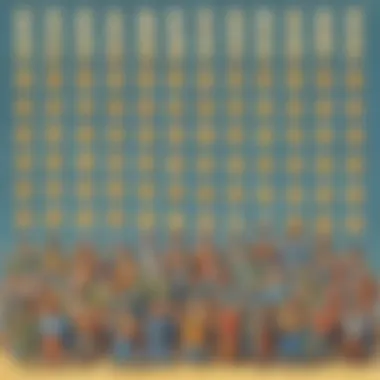Mastering Double Digit Multiplication Techniques


Intro
Double digit multiplication is a fundamental skill that builds the foundation for higher-level mathematics. Understanding how to multiply numbers with two digits is crucial for students, especially those in elementary school. This guide will explore various methods, strategies, and activities that enhance comprehension and retention of double digit multiplication. By mastering this topic, students can improve their overall arithmetic skills and gain confidence in their mathematical abilities.
In this article, we will also examine the importance of practice and offer engaging activities that make learning fun and effective.
Creative Activities
Engaging children in creative activities can enhance their learning experience. Here are some innovative ideas that align with double digit multiplication concepts:
Craft Ideas
- Multiplication Flashcards: Create flashcards that feature different double digit problems. Students can design these cards with colorful markers and illustrations, making learning visually appealing and interactive.
- Multiplication Board Game: Create a simple board game where each square presents a multiplication problem. Players can advance by solving these problems correctly, promoting both fun and education.
Step-by-Step Guides
- Creating Flashcards: Gather materials like cardstock, scissors, and markers. Cut the cardstock into small rectangles, and write a multiplication problem on one side. On the reverse side, write the answer. Use these for practice sessions.
- Designing Board Game: Use a large sheet of cardboard to create a game board. Mark out spaces with numbers. Each player rolls a dice and moves along the board, answering multiplication questions to advance.
Educational Value
These activities provide hands-on learning experiences. They can help children visualize mathematical concepts, making abstract ideas more concrete. Moreover, engaging with crafts can foster creativity alongside academic growth.
Fun Quizzes
Quizzes serve as excellent tools for reinforcing knowledge. Here’s how they can enhance learning in double digit multiplication:
Quiz Topics
The quizzes can cover:
- Basic multiplication facts
- Double digit multiplication methods, such as the standard algorithm or lattice method
- Real-world applications of multiplication
Question Types
You can include various question types:
- Multiple choice questions to select the correct answer
- Fill-in-the-blank questions to encourage recall
- True or false statements to assess understanding
Knowledge Reinforcement
Regular quizzes can reinforce learning by helping students track their progress. They can identify areas of difficulty and revisit those topics. Furthermore, quizzes maintain engagement, making learning less monotonous.
Fact-Based Articles
Incorporating informative articles can broaden a child's understanding of math and its various aspects:
Topics
The articles can explore:
- The history of multiplication
- Different methods used in multiplication worldwide
- The importance of mastering multiplication for future math topics
Engaging Content
These articles should be written in a straightforward manner, presenting facts clearly. The use of visuals, like graphs or illustrations, can further aid understanding. Engaging content empowers children to develop a natural curiosity about math.
Understanding Double Digit Multiplication
Double digit multiplication is a crucial concept in mathematics, particularly for elementary-age students. It lays the groundwork for more advanced mathematical operations and enhances problem-solving skills. Mastery of double digit multiplication not only improves arithmetic fluency but also builds confidence in students as they tackle more complex math challenges later on.
Definition and Importance
Double digit multiplication refers to the mathematical process of multiplying two numbers, each of which has two digits. This process is fundamental in everyday life, influencing various aspects of both academic learning and practical applications. Understanding this topic fosters a deeper comprehension of numbers and operations that go beyond basic single-digit multiplications.
The importance of mastering double digit multiplication can be summarized as follows:
- Foundation for Advanced Math: Mastering this skill prepares students for more advanced calculations, such as long division and algebra.
- Boosts Confidence: When students are proficient in basic multiplication, they are likely to feel more secure in their mathematical abilities.
- Cognitive Development: Engaging with multiplication helps enhance critical thinking and problem-solving skills.
In essence, a solid grasp of double digit multiplication equips students with the necessary tools to navigate their math journey successfully.
Real-World Applications
Double digit multiplication is not merely theoretical; it has practical applications in daily life. Here are some real-world scenarios where this skill is indispensable:
- Shopping: When calculating the total cost of multiple items, knowing how to multiply double digit figures is essential. For example, if an item costs $24 and you want to buy three of them, you would multiply 24 by 3 to find that you need to spend $72.
- Time Management: Understanding how to calculate time intervals, such as when planning events, requires multiplication. If you have 12 events and each lasts 30 minutes, you multiply to find the total duration.
- Cooking and Baking: Recipes often need adjustments. If a recipe serves four but you want to serve twelve, knowing how to multiply the ingredients is crucial.
Key Concepts in Multiplication
Understanding the fundamental principles of multiplication is crucial when progressing to double digit multiplication. Mastery of these concepts forms the bedrock for students as they navigate through more complex arithmetic operations. By grasping the basic principles and comprehending the place value system, students can approach double digit multiplication with confidence.


Basic Principles of Multiplication
Multiplication can be thought of as repeated addition. When multiplying two numbers, you are essentially adding one number to itself multiple times according to the value of the other number. For example, in the expression 4 × 3, you are adding 4 three times: 4 + 4 + 4, which equals 12. This understanding serves as a valuable stepping stone, especially in double digit multiplication where the numbers become larger.
It is important to recognize that multiplication has certain properties that can simplify calculations. These include:
- Commutative Property: This means that the order of the numbers does not matter. For instance, 3 × 4 is the same as 4 × 3.
- Associative Property: This property allows grouping of numbers in a way that can simplify the problem. For example, (2 × 3) × 4 is the same as 2 × (3 × 4).
- Distributive Property: This is essential in breaking down larger problems into smaller, more manageable parts. For instance, in multiplying 12 × 4, one could use (10 + 2) × 4 = (10 × 4) + (2 × 4).
Place Value in Double Digit Numbers
A clear understanding of place value is essential for working with double digit numbers. Each digit in a number holds a specific value based on its position. For example, in the number 23, the digit 2 represents twenty, while the digit 3 represents three. In double digit multiplication, recognizing this separation allows for proper calculations and organization.
When multiplying double digit numbers, it helps to break them down into their place values. For instance, when calculating 23 × 15, one can split the numbers:
- 23 = 20 + 3
- 15 = 10 + 5
Using distributive property, the calculation can be approached as:
- (20 × 10) + (20 × 5) + (3 × 10) + (3 × 5)
- This breaks down to 200 + 100 + 30 + 15
- Adding these results yields a total of 345.
Understanding place value not only allows for more accurate calculations but also builds a solid foundation for future mathematical endeavors. This clarity in the value of numbers simplifies the larger problems that students will encounter as they progress in their education.
Remember: Recognizing the role of each digit in a number simplifies double digit multiplication significantly.
By mastering these essential concepts, students will find themselves better equipped to tackle the intricacies of double digit multiplication. This foundational knowledge will serve them well in their continued mathematical journey.
Different Methods of Double Digit Multiplication
Understanding various methods of double digit multiplication is crucial for building proficiency in mathematics. Each method offers unique benefits and can cater to different learning styles. By exploring these methods, students can find the approach that resonates best with them, ultimately leading to a greater understanding and mastery of multiplication.
Standard Algorithm
The Standard Algorithm is the most commonly taught method for multiplying double digit numbers. In this approach, one number is written above the other, aligned by place value. The multiplication starts with the digit on the bottom right, moving left through each digit after completing the required calculations for a single digit.
- Multiply the units: Start with the rightmost digit of the bottom number, multiply it by each digit of the top number, writing results below.
- Multiply the tens: Next, move to the tens place of the bottom number and do the same, shifting the results one position to the left.
- Add results: Finally, add the two rows of numbers together to get the final product.
This method generates a clear structure and is efficient for carrying over values. It encourages accuracy as students learn to manage their calculations step by step.
Partial Products Method
The Partial Products Method breaks down the multiplication process into simpler steps. In this method, the focus is on multiplying each digit separately based on its place value and then summing the results.
For example, to multiply 23 by 45:
- Break it into parts: 20 and 3 from 23, and 40 and 5 from 45.
- Perform the following multiplications:
- Thus, the final step is to add up all the partial products: 800 + 100 + 120 + 15 = 1035.
- 20 x 40 = 800
- 20 x 5 = 100
- 3 x 40 = 1200
- 3 x 5 = 15
This method emphasizes understanding and can help students connect multiplication to addition. It is particularly beneficial for those who struggle with larger numbers, as it breaks the process into more manageable calculations.
Lattice Method
The Lattice Method is another effective approach, utilizing a grid to organize calculations visually. This method helps students understand multiplication as a whole while providing a structured way to work through the numbers.
- Draw a grid: Create a box for each digit in the numbers you are multiplying.
- Multiply: Fill in each box with the product of the corresponding digits, separating the tens and units with a diagonal line.
- Sum diagonally: Finally, add the numbers along the diagonal lines, carrying over as needed to get the final result.
This method might appeal to visual learners, allowing for a clear representation of each step in the multiplication process. It requires careful attention when writing numbers in the grid, promoting both accuracy and organization.
Overall, mastering these different methods of double digit multiplication equips students with diverse skills and helps solidify their understanding of arithmetic. Each method has its strengths and can greatly enhance mathematical learning.
By exploring and practicing these methods, students can approach multiplication with confidence.
Building a Solid Foundation
A solid foundation in arithmetic is crucial for students as they embark on mastering double digit multiplication. Understanding single digits and basic operations sets the stage for more complex calculations. When students struggle with simple multiplication, they often face challenges when faced with larger numbers. This section emphasizes the need to develop confidence in single-digit multiplication and introduces the distributive property, which serves as an important tool in simplifying complex problems.
Mastering Single Digit Multiplication
Before tackling double digit multiplication, it is essential to ensure students are proficient in single digit multiplication. This skill acts as a building block for further calculations. When children confidently recall multiplication facts up to 10, they can focus on the more intricate operations involved in double digits.
Here are some strategies that can assist in mastering single-digit multiplication:
- Repetition: Regular practice helps to reinforce memory.
- Pattern Recognition: Pointing out relationships, for instance, noticing that multiplying by 5 always results in a number ending with either 0 or 5.
- Visual Aids: Using charts or number lines can help with comprehension for visual learners.
Understanding single digit multiplication ensures that the learners are prepped for larger challenges ahead.
Understanding Distributive Property
The distributive property is a vital concept that empowers students to break down complex multiplication problems into simpler parts. It states that a(b + c) = ab + ac. By applying this property, students can manipulate two-digit numbers effectively.


For example, consider the multiplication of 24 × 5. Using the distributive property, a student can rewrite this as (20 + 4) × 5. This leads to:
- 20 × 5 = 100
- 4 × 5 = 20
Then add them together: 100 + 20 = 120.
Here are some benefits of mastering the distributive property:
- Simplification: It makes calculations easier by breaking numbers into manageable parts.
- Flexibility: Learners can choose how to break numbers based on what is comfortable or what is relevant to the problem.
- Conceptual Understanding: It fosters a deeper understanding of multiplication as repeated addition and offers a bridge to more advanced math concepts.
"Building a strong base in single-digit multiplication and understanding the distributive property is not merely about solving problems; it shapes the students' ability to think critically and handle numbers with confidence as they advance in their mathematical journey."
By focusing on these foundational elements, students can successfully approach double digit multiplication with a greater understanding and confidence.
Strategies for Effective Practice
Effective practice strategies are essential for mastering double digit multiplication. These methods help students develop confidence and proficiency in a core mathematical skill. By implementing structured practice, learners can reinforce their understanding and achieve fluency. This section explores various techniques that can enhance the learning experience while making it more engaging for students.
Create a Study Schedule
Establishing a study schedule is crucial for consistent practice. Without a predefined structure, students may find it challenging to dedicate time to multiplication practice. A study schedule should take into account the student's daily routine, balancing school, homework, and leisure activities. It is helpful to allocate specific times each day or week dedicated solely to multiplication practice, ensuring that skills are reinforced regularly.
A sample study schedule might look like this:
- Monday: 15 minutes of flashcard review in the evening.
- Wednesday: 30 minutes of online interactive quizzes.
- Friday: 20 minutes of game-based practice with a family member.
This routine encourages daily reinforcement without being overwhelming. Additionally, reviewing progress at the end of each week can motivate students and allow them to track their improvements.
Utilizing Flashcards
Flashcards are an effective tool for memorization and recall in double digit multiplication. They offer a simple way to practice multiplication facts in a focused manner. Creating a set of flashcards can be enjoyable and helps students actively engage in their own learning. Each flashcard should display a multiplication problem on one side and the answer on the other.
Some tips for using flashcards effectively include:
- Start with smaller double digit numbers before moving onto larger combinations.
- Mix up the order to improve retention.
- Use them in pairs or small groups, encouraging social interaction.
- Incorporate timed challenges to create a sense of urgency and make practice feel more dynamic.
By integrating flashcards into daily study habits, students can build speed and accuracy, enhancing their overall math skills.
Incorporating Games and Activities
Learning multiplication can be much more effective when it intertwines with play. Incorporating games and activities not only makes practice enjoyable, but also fosters a more relaxed environment, which can encourage better retention of skills. There are numerous multiplication games available—both physical and digital.
Some engaging activities to consider include:
- Board Games: Games like "Monopoly" or "Grocery Store" can be tailored to include multiplication questions.
- Online Platforms: Websites and apps, such as Kahoot! and Quizlet, provide interactive and competitive ways to practice multiplication.
- Hands-On Activities: Activities like dice rolling to create multiplication problems or using building blocks to visualize equations can enhance the learning experience.
These interactive methods encourage students to practice while being engaged, making it a less daunting task. Parents can participate in these games to offer support and cultivate a positive atmosphere around learning.
Important: Engaging in regular practice through various methods helps students not only master double digit multiplication, but also enjoy the learning journey.
Common Challenges in Double Digit Multiplication
In the realm of mathematics, double digit multiplication stands as a significant hurdle for many students. Recognizing and addressing common challenges can aid in better comprehension and proficiency. This section delves into the frequent pitfalls encountered when mastering double digit multiplication. By honing in on these challenges, educators, parents, and students can work collaboratively to improve skills and confidence.
Avoiding Common Mistakes
One of the primary obstacles in double digit multiplication is making basic mistakes. These errors often stem from misunderstandings of the multiplication process or miscalculations. Some common mistakes include:
- Misplacing Numbers: Students may accidentally switch numbers when writing them down, leading to incorrect products.
- Skipping Steps: In the rush to solve a problem, children might overlook crucial steps, especially in methods like the standard algorithm.
- Inaccurate Addition: Errors in adding partial products can occur, especially when carrying numbers over from one column to the next.
To combat these issues, it is essential for students to practice procedures slowly and methodically. Encouraging them to double-check their work helps build a habit of accuracy. Utilizing resources such as worksheets that specifically target multiplication pitfalls allows students to familiarize themselves with typical errors and strategies around them.
"Mistakes are the portals of discovery."
– James Joyce
Identifying Learning Gaps
Another challenge is identifying learning gaps in a student's understanding of double digit multiplication. Some may have solid knowledge of single-digit multiplication but falter under the weight of two-digit numbers. The reasons can vary:
- Lack of Foundation: If a student struggles with basic multiplication facts, they will face obstacles when advancing to double digits.
- Understanding Place Value: An insufficient grasp of place value can hinder a student from separating the tens and units during multiplication.
- Inconsistent Practice: Irregular or limited practice can leave knowledge stale, making it difficult to retain new concepts.
To identify these gaps, assessments such as quizzes or observational techniques during practice can be invaluable. Once gaps are identified, tailored intervention strategies can bridge these areas. Focusing on foundational skills is critical; for example, reinforcing single-digit multiplication through games or flashcards can help in gradually building confidence. Additionally, parents and educators can encourage an open dialogue with children about their difficulties, fostering a supportive environment for learning.
In summary, navigating common challenges in double digit multiplication requires a combination of vigilance, structured practice, and open communication. Through meticulous attention to detail and understanding, students can enhance their mathematical journey.
Assessing Understanding
Assessing understanding in double digit multiplication plays a crucial role in ensuring that students not only grasp the methods but can also apply them effectively. It allows educators and parents to determine where a student excels or struggles. Understanding the progress students make can inform future teaching strategies, focusing on areas where they need enhancement. Assessing understanding also builds confidence in learners as they see their improvements over time. Thus, incorporating various assessment methods is vital in this educational journey.
Quizzes and Self-Assessment


Quizzes serve as a valuable tool in evaluating a student's mastery of double digit multiplication. These assessments can be used in different formats, from multiple choice to open-ended questions. Regular quizzes help identify areas of difficulty. A quiz that includes a variety of problems can highlight specific challenges, such as mistakes with place value or operational errors. Students who review their quizzes learn to recognize their own mistakes, encouraging a growth mindset about their learning.
Self-assessment methods can also be empowering for students. They involve reflecting on their understanding and performance. For instance, after completing a practice session, students could ask themselves questions like: "What strategies worked for me?" or "Where do I need more practice?" This approach fosters a sense of ownership over learning and can guide them in setting personal objectives in multiplication.
Peer Collaboration for Feedback
Peer collaboration facilitates meaningful discussions about double digit multiplication strategies among students. Working together allows students to explain their thinking to one another. This practice of articulating ideas can deepen their understanding.
Feedback from peers can often highlight nuances that might not be evident in teacher assessments. For example, a student may explain a method that resonates better with their classmates than the standard approach. Moreover, peer review promotes a safe environment for asking questions. Students may feel more comfortable sharing uncertainties with friends instead of adults.
Ultimately, utilizing both quizzes and peer collaboration nurtures a comprehensive understanding of double digit multiplication. These strategies empower students to take control of their own learning journey while encouraging them to support one another in mastering important skills.
Utilizing Online Resources
In today's educational landscape, online resources play a pivotal role in supporting learning. For topics such as double digit multiplication, these resources provide an avenue for students to enhance their understanding outside the classroom. Parents and caregivers can leverage these tools to create a more engaging learning environment. Access to educational websites and interactive apps allows for practice that is often more enjoyable than traditional methods, facilitating better retention of mathematical concepts.
Educational Websites
Numerous educational websites cater specifically to the needs of students. Websites such as Khan Academy and IXL offer targeted lessons that cover double digit multiplication in detail. These platforms provide video tutorials and practice problems that adapt to each student's learning pace. The interactive nature of these websites encourages students to tackle challenging problems without overwhelming them.
Some benefits of utilizing educational websites include:
- Structured Learning: Lessons that build on each other systematically.
- Instant Feedback: Many sites provide immediate feedback on quizzes and practice problems, helping students learn from their mistakes.
- Diverse Content: Available resources often include games, worksheets, and multimedia that can cater to different learning styles.
While using these resources, it is essential for parents to monitor progress and ensure that the content aligns with what is being taught in the classroom.
Interactive Apps
Interactive apps are another excellent method for mastering double digit multiplication. Apps like Prodigy Math and Mathway offer game-like environments where students can practice multiplication in a fun and stimulating way. These apps often include progress tracking features, enabling parents to review their child’s improvement over time.
Consider these key advantages of using interactive apps:
- Engagement: The game-based format keeps learners motivated and interested in practicing math skills.
- Accessibility: With apps, students can learn at their convenience, making it easier to fit practice into a busy schedule.
- Personalized Learning Experience: Many apps adjust difficulty levels based on individual performance, allowing students to work at their own pace.
"Learning through play is proven to enhance retention and understanding in children. The right apps can make math feel less like a chore and more like an adventure."
By incorporating both educational websites and interactive apps into learning, students can gain a well-rounded understanding of double digit multiplication. Utilizing these online resources not only provides additional practice but fosters an environment of discovery and engagement for students.
Parents' Role in Learning Multiplication
The involvement of parents in the learning process of their children cannot be underestimated. Specifically, in the realm of mathematics, a parent's active engagement can significantly enhance a child's understanding and enjoyment of double digit multiplication. When parents take on an active role, they help create a positive attitude toward math, which is crucial for the success of young learners. The environment that parents foster can have lasting effects on a child's confidence and ability to grasp complex concepts.
Positive reinforcement from parents encourages children to tackle challenging problems without fear. It also creates a sense of security for them, knowing they have support in their learning journey. This section will detail how parents can contribute effectively to mastering multiplication and highlight specific practices that can enhance their involvement.
Creating a Supportive Learning Environment
To create a supportive learning environment, parents must first cultivate a space where learning can take place comfortably. This does not necessarily mean a physical space like a designated study area, although that can help. It is more about fostering an atmosphere that prioritizes education and emphasizes the value of hard work. Families should celebrate small victories, such as mastering a multiplication fact, to keep morale high.
Key Elements of a Supportive Environment:
- Encouragement: Positive words can motivate children to persist even when faced with difficult tasks.
- Understanding: Parents should recognize that each child learns at their own pace and may require different approaches to learning.
- Resource Availability: Provide access to educational materials, including books, apps, or games that reinforce multiplication skills.
Encouraging Daily Practice
Daily practice is essential in developing fluency in double digit multiplication. For children, regular exposure to the material helps solidify knowledge and aids retention. Parents can play an important role by encouraging consistent practice without making it feel like a chore. This could involve short sessions each day, focusing either on practice problems or fun multiplication games that make learning enjoyable.
Effective Strategies for Daily Practice:
- Set a Schedule: Establish a regular time for practice to create a routine.
- Make It Fun: Use educational apps or games to keep children engaged.
- Integrate into Daily Life: Identify opportunities in everyday situations, like measuring ingredients while cooking, that can be related to multiplication.
A consistent and supportive practice routine not only improves skills but also builds a child's confidence in mathematics.
In summary, the role of parents in their child's learning of double digit multiplication is profound. By creating a nurturing environment and encouraging daily practice, parents can significantly contribute to their child's success. Moreover, as children become more confident in their multiplication skills, they are likely to develop a more positive attitude toward math in general.
End and Next Steps
In wrapping up our exploration of double digit multiplication, it is essential to recognize its significance. Mastering multiplication not only establishes a foundation for future math skills, but it also enhances problem-solving abilities and critical thinking. This section emphasizes two vital components: a recap of key points and setting actionable goals for continued practice.
Each method discussed in earlier sections provides valuable tools for consolidating this skill. The Standard Algorithm, Partial Products Method, and Lattice Method serve as gateways to diverse approaches in mathematical thinking. Additionally, understanding the importance of place values and the distributive property contextualizes multiplication within broader mathematical concepts.
By considering these methods and principles, learners can eliminate confusion and build confidence in their abilities. Parents and educators play a crucial role in facilitating a supportive environment conducive to practice and improvement. Continuity in practice is emphasized here, as regular engagement with multiplication problems will reinforce understanding and mastery.
Effective mastery of double digit multiplication empowers students for higher-level mathematical tasks and everyday problem-solving.
Recap of Key Points
- Methods of Multiplication: The three primary methods—Standard Algorithm, Partial Products, and Lattice—provide different perspectives on handling double digit multiplication.
- Foundation: A strong understanding of single digit multiplication, place value, and the distributive property is essential for moving to double digit multiplication.
- Practice Strategies: Utilizing resources such as study schedules, flashcards, and interactive games helps reinforce skills while keeping the learning process engaging.
- Assessment: Regular quizzes, peer feedback, and self-assessment techniques can assist in identifying strengths and areas for improvement.
- Parental Involvement: Creating supportive environments at home can significantly impact a child's learning process.
Setting Goals for Continued Practice
Establishing specific, measurable, achievable, relevant, and time-bound (SMART) goals is crucial for continued practice in double digit multiplication. Here are some actionable steps:
- Daily Practice: Schedule a specific time each day for short practice sessions to reinforce skills. Aim for at least 10-15 minutes daily; this consistency builds confidence.
- Skill-Building Milestones: Set specific goals, such as mastering one multiplication method before moving to the next or aiming to complete a certain number of practice problems each week.
- Use Resources: Integrate various materials like educational apps and websites for diverse practice opportunities, tailoring them to the child's learning style.
- Reflect and Adjust: Encourage students to reflect on their progress weekly. If they find certain areas challenging, adjust practice goals accordingly.
By setting goals that are clear and realistic, students can maintain focus and motivation in their journey toward mastering double digit multiplication. This structured approach paves the way for not just mathematical proficiency, but also a broader sense of accomplishment.







